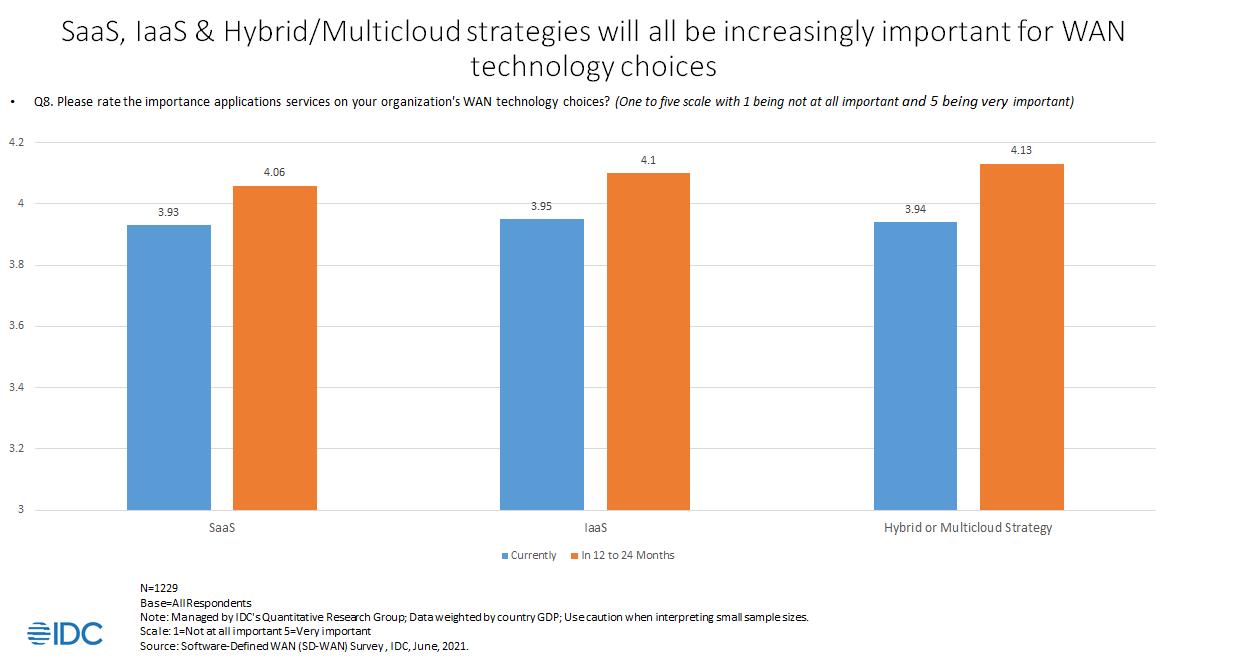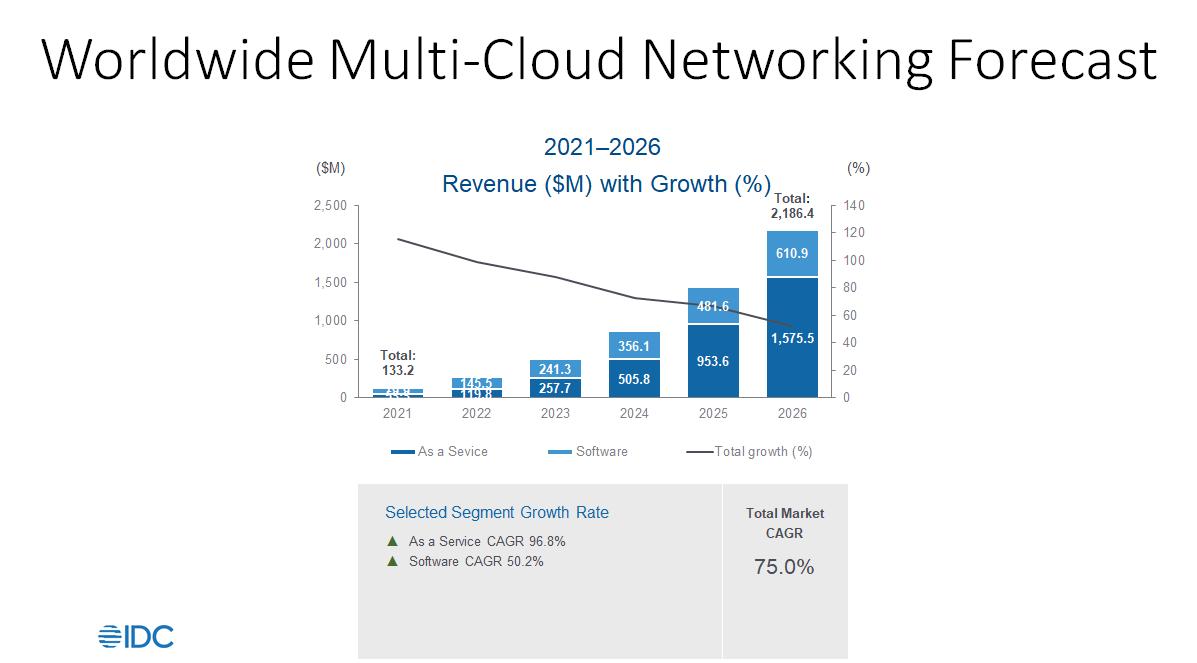
By Guy Matthews, Editor of NetReporter.
Multi-cloud networking really matters. It has evolved in short order to become a vital consideration for enterprises and organizations worldwide. In consequence, the likes of AWS, Google Cloud, Microsoft Azure, as well as many other platforms, have seen tremendous growth rates on a year-to-year basis.
“This is because these clouds have become so important for the realization of enterprise digital transformation,” believes Brad Casemore, VP Research, Datacenter and Multi-cloud Networking with analyst firm IDC. “These platforms are not only destinations for workloads but are central to the redefinition of operating models for IT organizations. And all this has had a tremendous effect on the network, because we have moved from hosting applications in on-premise data centers to a distributed landscape that includes cloud and increasingly, as we move forward, edge environments.”
The network, he says, has had to be modernized to meet all these changes: “It needs to be able to bring a degree of simplicity without a compromise on performance and security. It needs to offer elastic scale, as well as many cloud attributes in terms of being API-based and more software-defined. And it needs to do this across a more distributed and complex landscape than we’ve ever seen before.”

Figure 1: Multi-cloud and WAN technology choices.
IDC conducted recent research into how certain types of application are affecting technology choices across the wide area network: “These are very important considerations for enterprise IT organizations and buyers,” notes Casemore. “Another aspect of this is applications access and the digital experience, the consumption side of things. You have to consider things like security, and latency, and applications performance. We’re seeing a lot of work being done by SDN vendors to integrate with cloud transport networks. We’re also seeing the way that cloud-native technology is changing the networking picture and making new demands on networks.”

Figure 2: The future of multi-cloud.
IDC foresees an impressive multi-cloud adoption growth rate through to 2026: “I see tremendous prospects, and it all speaks to the problems that enterprises are trying to solve with effective technology,” concludes Casemore.
To extend the dialogue, Casemore turns to a number of multi-cloud stakeholders, including Jim Brinksma, Chief Technology Officer with Megaport, a global network service provider with approximately 2,500 customers. He agrees that connectivity is key: “Without the right network connectivity, the overall cloud migration experience can really suffer,” he says.
“Other obstacles include initial procedural efforts like creating your credentials plus the educational efforts that are associated with trying to understand the different naming conventions of the features and how they align. Then there’s understanding how network egress charges could impact your ability to distribute certain workloads. Networking is an enabler but there will always be little speed bumps that that you’ll have to go over as you’re getting your feet wet and learning how to get into the networking game in a multi-cloud environment.”
It’s relatively easy to get started with cloud migration, but the complexity soon exponentially increases, concurs Bryan Ashley, Vice President of Solutions Management & Marketing with Aviatrix, creator of a secure cloud networking platform for public cloud and edge use: “It’s about how to instantiate a framework or a landing zone that scales over time and supports massive amounts of workloads, and maintains consistent connectivity and redundancy as well as security and governance.”
Sreekanth Kannan, VP of Product Management & Marketing with Arrcus, a hyperscale networking and software company, says his company looks at the multi-cloud market as three different segments: “There’s the global 2000, the mid-market enterprise and the small enterprise,” he notes. “The bulk of it is mid-market enterprise and global enterprise, which have their own DevOps teams in IT teams. The way they normally start is with a hybrid cloud to see how well that goes. You need to provide an on ramp, because you cannot make it into a complete lift and shift. The first steps are baby steps – crawl, walk, run.”
Ashley of Aviatrix believes that multi-cloud challenges are made harder by a widening skills gap with organisations often employing a lean team to try to figure a way past the various challenges: “Whether they are deploying single cloud or multi- cloud, inevitably they have to operationalize the thing. They often turn it over to some tier one people to run and make sure that everything is up.”
Ashley recalls something his mother used to tell him: “It’s all fun and games until someone loses an eye,” he says. “And the reality is that enterprises are starting to lose some eyes. It can be easy to get started, but soon things can get out of control. Businesses need to be able to put in some structure and develop a true strategy. They need to be able to operationalize it all. We’re all looking for ways to start to do things in a repeatable fashion, one that allows us to really have the control that we need.”
Ranga Rajagopalan is VP, Chief Architect with VMware, and his responsibility includes networking security and load balancing: “I believe the key is security,” he says.
“Every organization is going to get breached or hacked. When that happens the question how far and where did that spread? What applications got hacked? Do we have full visibility to contain the breach? And what do we do about it? Without good quality multi-cloud networking and security, the answer is you don’t know. Perhaps after days or weeks and a lot of work you still don’t know. As an industry, we have to provide the right solutions in a way that people can actually use without the need to get PhDs in every networking, security and application delivery technology.”
Kannan of Arrcus reminds the panel that it is still early days in most people’s multi-cloud journey: “Just think of the percentage of workloads that are actually in the cloud, versus distributed on-prem and other places,” he urges. “We haven’t crossed the halfway mark. Yes, there are some organizations that are completely cloud native, that have decommissioned their data centers, but not many.”
Brinksma of Megaport concludes with a reminder that it is sometimes important to take a step back and truly understand what people are trying to achieve with multi-cloud: “That is probably the first thing you should be doing, and it can lead you in the right direction. Then it’s about things like automation, and being able to have the appropriate tooling, not only for Day Two but moving forward. That means having the ability to look at metrics across all the different clouds and be able to make those metrics actionable.”
Wrapping up the discussion, IDC’s Casemore offers these thoughts: “Of the people IDC has spoken to about multi-cloud, many of them say ‘I didn’t realize the network infrastructure implications of going hybrid and going multi-cloud and particularly of going up the stack to cloud-native’. But I think it’s important to understand that if you have the right criteria in place, you can simplify this journey to a large extent.”





